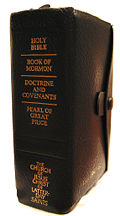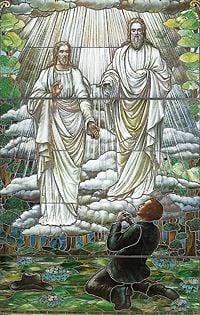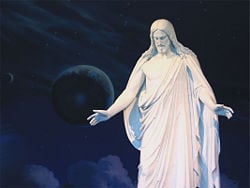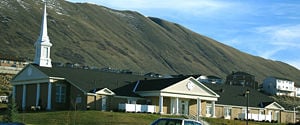Church of Jesus Christ of Latter-day Saints
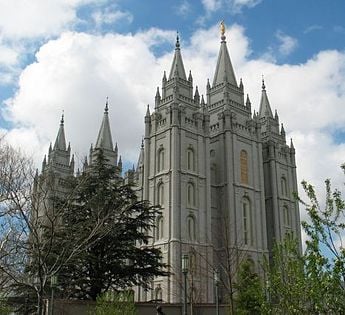
The Church of Jesus Christ of Latter-day Saints, widely known as the "LDS Church" or the "Mormon Church", is the largest and most well-known denomination within the Latter Day Saint movement. Founded in the United States by Joseph Smith Jr. in 1830, the Latter-day Saints regard Jesus Christ as the head of their church and count themselves as Christians, but do not consider themselves part of the Catholic, Orthodox, or Protestant traditions.
The church is headquartered in Salt Lake City, Utah, and is said to be the fourth largest religious body in the United States [1]. Members living in the US and Canada constitute 47% of membership, Latin America 36%, and members in the rest of the world 17% (See membership distribution).
History
Members of the church — known as Latter-day Saints — believe their church to be the restoration of the church that was established by Jesus Christ in New Testament times, and that this resoration was performed personally by Jesus Christ. They believe that following the ascension of Jesus Christ into heaven he continued to direct his church through his apostles, but eventually the authentic Christian church began to disappear, leading ultimately to the Great Apostasy. The church claims that the original teachings of Christ and his followers was thereafter influenced by Hellenistic philosophy and littered with false doctrines, which led to misinterpretation of many scriptures.
Church members believe that in the spring of 1820, God the Father and His Son, Jesus Christ, appeared to a 14-year-old boy, Joseph Smith, Jr., in response to his prayer inquiring which sect he should join. He was commanded to join none of the existing churches, and through other angelic visits was eventually called as the first prophet of the restored church. Ten years later, after a series of other revelations and visitations, The Church of Jesus Christ of Latter-day Saints was officially founded by Joseph Smith, Jr. and five associates on 6 April 1830, in Fayette, New York.
The Church suffered persecution in several states, including a government-ordered extermination order (directed at the Church) from Lilburn W. Boggs, governor of Missouri, and Smith was eventually killed by a mob on June 27, 1844 in Carthage, Illinois, along with his brother Hyrum. Brigham Young, then President of the "Quorum of the Twelve Apostles," was elevated by the majority of the church as the next Prophet and President of the church. Faced with further persecution in Illinois, members of the church eventually followed Brigham Young to the Salt Lake Valley, and settled a large area now encompassed by the state of Utah and parts of Arizona, California, Nevada, Idaho, and Wyoming.
Name and Symbols of the Church
Initially, when the Church was organized in 1830 it was called the "Church of Christ". Overtime, it became referred to as the "Church of Latter Day Saints" to differentiate it from other Christian groups, and was generally known by that name between 1834 and 1838. In April 1838, the full name was stated as "the Church of Jesus Christ of Latter Day Saints", according to direction recorded in Doctrine and Covenants 115:3-4.
Today, the Church is commonly referred to as the "LDS Church" in Utah and surrounding areas, while it is more often known as the "Mormon Church" throughout the rest of the world. Church members are often known simply as "Mormons", "the Saints", or "Latter-day Saints" with the latter two being the preferred terms by most Latter-day Saints themselves. Occasionally, these names may bring about confusion, as other groups outside the church are sometimes alluded to using these same terms. Of all of the Latter Day Saint groups, however, The Church of Jesus Christ of Latter-day Saints is the one most commonly meant when using these terms. The nickname "Mormon" arose soon after the publication of The Book of Mormon in 1830. Although originally used pejoratively to refer to the church or its members, the term came to be used within the church.
Latter-day Saints do not use the Christian cross or crucifix as a symbol of their faith. Most modern Latter-day Saints choose to focus upon Jesus' life, atonement, and resurrection, not his death. One of the central visual symbols of the Church is the trumpeting angel Moroni, proclaiming the restoration of the "true gospel" to the Earth (usually identified as the angel mentioned in Revelation 14:6–7); and a statue depicting the angel often tops the tallest spire of LDS temples. Another common symbol in the Church is the letters CTR, meaning "Choose the Right", taken from the name and motto of a children's Primary class.
Church Organization
The head of the church is termed President, who the members revere as the Prophet, seer, and revelator. He is entitled to receive revelation from God to guide the church and the world as His mouthpiece on the earth. Other authorities of the church include Apostles, Seventies, Stake Presidents, Bishops, and other quorum presidents. Within the church there are two important apostolic bodies: the "Quorum of the Twelve Apostles" and the "Quorum of the Seventy," both charged with the spreading of the Latter-day Saints' message. The "Quorum of the Twelve" is in place directly under the President, and the "Quorum of the Seventy" (referred to as "Seventies") ranks below the Twelve. The president of the church serves as such until death, after which the "Quorum of the Twelve Apostles" will meet, pray, and under the leadership of the senior apostle, receive revelation as to whom the next prophet should be. Although not specified by revelation, the senior apostle has historically become the new President of the church.
Members of The Church of Jesus Christ of Latter-day Saints address each other as "Brother" or "Sister" and then usually append the last name (such as Brother Smith, or Sister Young). Additionally, those that hold specific leadership positions may be addressed by their title and then their last name (such as President Kimball). Some frequently-used titles are as follows.
- Bishop - Local Bishops of a ward are addressed by the title of "Bishop". There is also a position in the LDS church referred to as the Presiding Bishop. The Presiding Bishop oversees the welfare services of the Church.
- Elder - While most adult male Church members hold the office of "elder", in general only full-time male missionaries (proselyting or service), members of any of the "Quorums of the Seventy" (General & Area Authorities), and members of the "Quorum of the Twelve Apostles" are addressed with this title.
- President - In a Ward, the Elder's Quorum President is referred to as "President". Other presidents within the ward, such as the Teachers or Deacons Quorum President, may be referred to with this title. In addition to the above presidencies, in a branch, the branch president is referred to as "President", and his councilors are referred to as "Brother." . All members of a Stake (or District) Presidency, a Temple Presidency, a Mission Presidency, the Presidency of the Seventy, and the First Presidency are referred to as president.
Congregations for Sunday services are grouped geographically, with larger (200 to 400 people) congregations known as "wards", and smaller (less than 200 people) congregations known as "branches".
Scriptures
Under the Church's doctrine of continuing revelation, the Church has an open scriptural canon which thus far includes the Hebrew Bible, Christian New Testament (King James Version), The Book of Mormon: Another Testament of Jesus Christ, The Doctrine and Covenants, The Pearl of Great Price, and The Articles of Faith. These scriptural writings comprise the Standard Works of the Church. This belief in additional scriptural canon makes the church unique among Christian groups. Though the canon is still open documents are not added frequently.
According to tradition, Joseph Smith, Jr. translated the Book of Mormon by the power of God. The Book of Mormon details the journey of nations from Jerusalem in 600 b.c.e.. called the Nephites and the Lamanites to the Americas, and another group called the Jaredites who existed there prior. It also details the ministry of the resurrected Jesus Christ to the Nephites.
The Doctrine and Covenants is a collection of revelations, policies, letters, and statements from Church presidents, starting with Joseph Smith. This record contains Church doctrine as well as direction on Church government.
The Pearl of Great Price contains: (1) excerpts from Joseph Smith’s translation of Genesis, called the book of Moses, and of Matthew 24, called "Joseph Smith—Matthew"; (2) Joseph Smith’s translation of some Egyptian papyrus that he acquired in 1835 (and subsequently lost, although some pages were purportedly rediscovered in 1967), called the "Book of Abraham"; (3) an excerpt from The Documentary History of the Church containing a letter written by Joseph Smith in 1838, called "Joseph Smith—History"; and (4) an excerpt of another of Joseph Smith's letters called the Articles of Faith, thirteen statements of belief and doctrine.
Major Beliefs
The Church of Jesus Christ of Latter-day Saints shares many beliefs in common with other Christian groups, though it differs in theology from these traditions, especially in its ideas about God and the Trinity, Salvation and Heaven.
=== The Godhead ===
LDS theology understands that God the Father, Jesus Christ, and the Holy Ghost are three separate and distinct personages who together comprise the Godhead or The Holy Trinity (which is different from the doctrine of the Triune God in other Christian traditions, which maintains that the three are one being). All three members of the Godhead are eternal and equally divine, but play somewhat different roles. While the Holy Ghost is a spirit without a physical body, God and Christ do possess distinct, perfected, physical bodies of flesh and bone. Although Mormon theology sees the Father, the Son, and the Holy Ghost as separate beings, they are considered to be "one God" in purpose.
The Plan of Salvation
The term Plan of Salvation (a.k.a. the Plan of Happiness) is used to describe how the gospel of Jesus Christ is designed to bring about the immortality and eternal life of humankind. It includes the Creation, the Fall, and the Atonement, along with all God-given laws, ordinances, and doctrines. Members believe that after this life is the Resurrection and Judgement.
The gift of immortality is also believed to be freely given to all because of Jesus' sacrifice on the cross and his subsequent Resurrection, although salvation from sin is conditional. Entrance to the highest Heavenly Kingdom, the "Celestial Kingdom", is only granted to those who accept Jesus through baptism into the Church by its priesthood authority, follow Church doctrine, and live righteous lives. Faith alone, or faith without works is not considered sufficient to attain exaltation.
Kingdoms
According to the Church, the Celestial Kingdom (whose glory is compared to the brightness of the sun in the sky, whose inhabitants have all truth and light) is where the righteous will live with God with their families. This kingdom includes multiple degrees of glory, the highest of which is exaltation. Those who have had the ordinances of eternal marriage, which is performed in Temples, and baptism may be exalted if they are found worthy by God. Accountable individuals must be baptized and repent to gain entrance to the Celestial Kingdom; Latter-day Saints profess that all children who die before the age of accountability (eight years old) automatically inherit a celestial glory.
Good people who do not follow Jesus or accept the Gospel (as understood by the Church) do not qualify for exaltation and will be consigned to the Terrestrial Kingdom (whose glory is compared to the brightness of the moon in the sky). This kingdom is one of great glory, but without the presence of God the Father. An ultimate willingness to keep the Ten Commandments is considered essential to enter this kingdom.
Murderers, other criminals, and the like who do not accept the Atonement of Jesus Christ will eventually spend eternity with people of like intent in the Telestial Kingdom, and their glory will be as that of the stars in the night sky. This is also considered a kingdom of glory and has been described as being much better than even earthly life. All those who do not qualify for a higher degree of glory will automatically enter this kingdom unless they deny the Holy Ghost, a sin it is believed very few people are able to commit.
Those few people who do, after gaining a full knowledge of the Gospel, willfully deny and contend against the Holy Ghost, are believed to inherit no glory. Most members of the Church refer to this place as Outer Darkness. An individual so banished is called a Son of Perdition. Forgiveness is not possible for these souls, though they will be resurrected and judged by Jesus Christ during the Second Coming.
Baptism
The Church of Jesus Christ practices baptism by immersion in water. Baptism is symbolic of burial and rebirth as a disciple of Jesus Christ. Like many Christians, Latter-day Saints believe that a person who repents and is baptized has all prior sins remitted.
Baptism is never performed before the eighth birthday. The age of eight was given in latter-day revelation as the age when children become accountable for their sins. If a person is unable to discern between right and wrong (ie. those with limited mental capacities) they are deemed unaccountable for their sins and do not require baptism, regardless of their age. The Book of Mormon and modern revelation specifically forbids the practice of infant baptism. (See Doctrine and Covenants 68:27 and Moroni 8:4-23.) Baptism is recognized only when performed by one holding the proper authority, contained in the office of a Priest in the Aaronic Priesthood, or a higher office.
Latter-day Saints also practice Baptism for the dead, a practice that is unique to the Church. This practice is a baptism by proxy and is performed in a temple by worthy members. This practice is believed to only take effect if the deceased person has repented of their sins and accepted the ordinance.
Following baptism by immersion, individuals are confirmed members of the church and given the Gift of the Holy Ghost by the laying on of hands by Priesthood bearers worthy to do so. Latter-day Saints believe that this blessing entitles the newly confirmed recipient to have the constant companionship of the Holy Ghost as a guide and guardian so long as the recipient lives worthy of the gift. Moreover, members believe that those who have not been confirmed may still receive inspiration and a witness from the Holy Ghost but are not entitled to constant companionship available through the gift of the Holy Ghost.
== Chapel and Temple Services ==
Weekly worship services, including Sacrament Meetings, are held on Sundays, in meeting houses, also referred to as "chapels" or "stake centers". All people, regardless of belief or standing in the church are welcome to attend. The Sacrament, similar to Communion or the Eucharist in other churches, — consecrated bread and water (in place of wine) in remembrance of the body and blood of Christ —is offered weekly.
The primary Sunday service is sacrament meeting and attended by the combined congregation. The foremost purpose of sacrament meeting is the blessing and passing of the Sacrament to members of the Church. After the Sacrament, the service usually consists of two or three "talks" (lay sermons) prepared and delivered by members of the congregation. Once a month however, usually on the first Sunday, instead of prepared talks, members are invited to bear their testimonies about gospel principles. Hymns are sung throughout the service.
During the other two segments, the congregation divides into smaller groups based on age and/or gender. The church publishes manuals for each type of class, usually including a teacher's manual as well as a student booklet for youth and adult classes.
In addition to Sunday worship, members of the church may participate in ordinances in temples, including baptisms for the dead, endowments, and eternal marriage. Adult members who receive their endowments in the temple also receive the temple garment, which they wear under their daily clothing. The LDS church considers the temple ordinances exceptionally sacred. As such, they do not publicly release the details of the temple proceedings and expect that members also do not discuss them outside the temple. This is true of the significance of the temple garment as well.
Other Practices
Practices distinctive to Latter-day Saints include following the "Word of Wisdom" (caring for one's body by eating healthy foods; abstaining from alcohol, tobacco, tea and coffee, and illicit drugs; and eating meat sparingly), tithing (donating 10 percent of one's income to the church, which is voluntary), chastity, modesty in dress and behavior, lay leadership, Family Home Evenings (families are encouraged to meet weekly for prayer and other activities), and home and visiting teaching (members regularly visit one another in their homes for prayer and study).
Missionaries
The LDS Church has one of the most active missionary programs of any world church. Missionary work is a fundamental principle of the Church, and has become one of the most readily identifiable characteristics of The Church of Jesus Christ of Latter-day Saints. All missionaries have been assigned by Church headquarters to their area of work, which can be in any part of the world where governments allow them to preach. They support themselves financially for up to two years, and often learn a second language. The Church also places an emphasis on humanitarian services, and vast family history resources.
Polygamy
At one time in its early history, the Church did endorse a form of polygamy called "plural marriage," but this is no longer the case. The practice was officially withdrawn as stated in a declaration called "The Manifesto" which was given by President Wilford Woodruff in 1890 (see Official Declaration 1), which advised Church members to obey the marriage laws of their land. The Church's position was reiterated and clarified in 1904 (commonly referred to as "The Second Manifesto"), with an additional request that no Church members enter into any form of plural marriage, regardless of their location, local customs, or legality. Members of The Church of Jesus Christ of Latter-day Saints found to be engaging in multiple marriage relationships are excommunicated. Converts from areas where polygamy is an accepted practice typically must end such relationships.
External links
- LDS.org - the official website of The Church of Jesus Christ of Latter-day Saints — with links to Gospel Library, Church History, Family Home Evening programs, and more
- Mormon.org - information on basic beliefs, a meetinghouse locator, and a place to email questions
- JosephSmith.net - the official web site on Joseph Smith by the Church
- LDSFAQ at byu.edu - a comprehensive index answering many common questions. Uses large portions of The Encyclopedia of Mormonism
- About Mormonism - Useful advice and presentations on Mormon belief and practice
- FARMS - Foundation for Ancient Research and Mormon Studies (BYU)
- Dialogue: A Journal of Mormon Thought Read 40 years of the best Mormon studies by top LDS Scholars, Researchers, and Writers on all topics that relate to the Mormon experience.
- Mormon Social Science Association
- The Association for Mormon Letters
- The Mormon History Association
ReferencesISBN links support NWE through referral fees
- Oxtoby, Willard G., editor, World Relgions: Western Traditions. Oxford University Press, 2002. ISBN 0-19-541520-5
- Walker, Ronald W., et al, Mormon History. University of Illonois, 2001. ISBN 0-25202619-5
- Johanson, W. F. Walker, What Is Mormonism All About?. St. Martin's Press, 2002. ISBN 0-312-28962-6
Credits
New World Encyclopedia writers and editors rewrote and completed the Wikipedia article in accordance with New World Encyclopedia standards. This article abides by terms of the Creative Commons CC-by-sa 3.0 License (CC-by-sa), which may be used and disseminated with proper attribution. Credit is due under the terms of this license that can reference both the New World Encyclopedia contributors and the selfless volunteer contributors of the Wikimedia Foundation. To cite this article click here for a list of acceptable citing formats.The history of earlier contributions by wikipedians is accessible to researchers here:
The history of this article since it was imported to New World Encyclopedia:
Note: Some restrictions may apply to use of individual images which are separately licensed.

